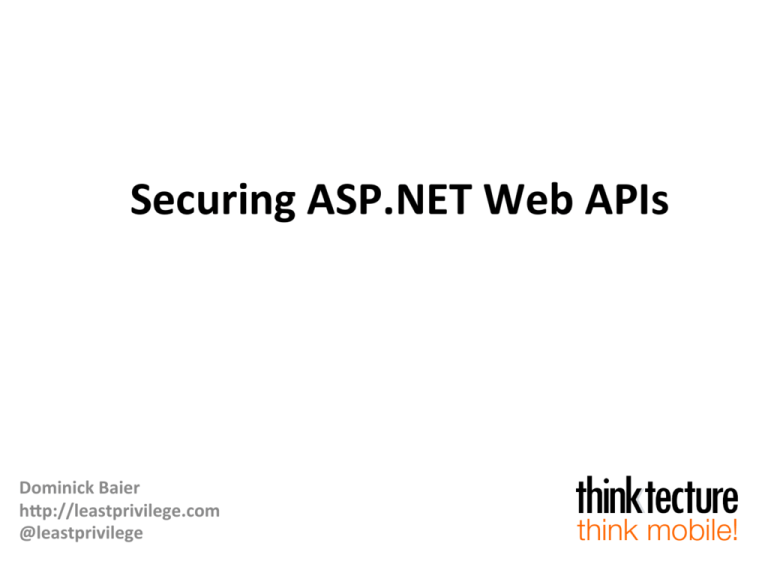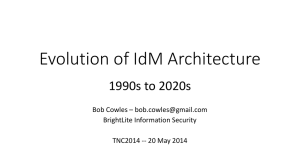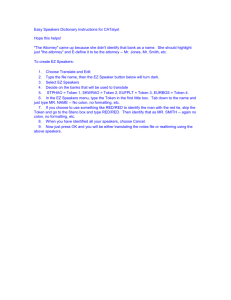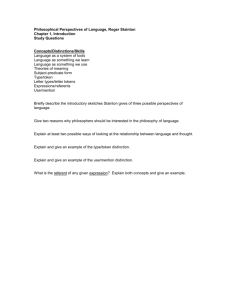Securing ASP.NET Web APIs
advertisement

Securing ASP.NET Web APIs Dominick Baier h;p://leastprivilege.com @leastprivilege think mobile!
Dominick Baier • Security consultant at thinktecture • Focus on – security in distributed applica9ons – iden9ty management – access control – Windows/.NET security – mobile app security •
•
•
•
MicrosoF MVP for Developer Security ASP.NET Web API Advisor dominick.baier@thinktecture.com h;p://leastprivilege.com think mobile!
@leastprivilege 2 Agenda • HTTP security & SSL • ASP.NET Web API v2 architecture • ApplicaNon scenarios •
•
•
•
•
(Token-­‐based) authenNcaNon AuthorizaNon CSRF CORS OAuth2 @leastprivilege 3 ASP.NET Web API: the big picture Host HTTPS @leastprivilege ASP.NET Web API 4 Developers & SSL @leastprivilege 5 Security model for HTTP-­‐based services • Simple model – HTTP + content + SSL • Whenever authenNcaNon is required – Status code of 401 indicates unauthorized – WWW-­‐Authen0cate response header indicates preferred authen9ca9on method Status Code: 401 unauthorized WWW-­‐AuthenNcate: Scheme realm="myapp" @leastprivilege 6 Authen9ca9on for HTTP-­‐based services • CredenNals transmi;ed (typically) via Authoriza.on header • e.g. Basic authen9ca9on, access tokens… • some9mes other means (query string, cookie…) GET /service/resource AuthorizaNon: scheme credenNal @leastprivilege 7 The Web API v2 Security Pipeline Host OWIN/
Katana Host/Framework independent concerns, e.g. authen9ca9on Web API MessageHandler (global/per-­‐route) AuthenNcaNon Filter AuthorizaNon Filter Web API cross-­‐cu[ng concerns, e.g. CORS Web API specific authen9ca9on Authoriza9on h;p://www.asp.net/vnext/overview/owin-­‐and-­‐katana/an-­‐overview-­‐of-­‐project-­‐katana @leastprivilege 8 Katana Authen9ca9on Middleware public class Startup { public void Configuration(IAppBuilder app) { app.UseCookieAuthentication(new CookieAuthenticationOptions { AuthenticationType = "Cookies", // more options }); app.UseGoogleAuthentication(new GoogleAuthenticationOptions { AuthenticationType = "Google", // more options }); app.UseOAuthBearerAuthentication(new OAuthBearerAuthenticationOptions { AuthenticationType = "Bearer" // more options }); } } @leastprivilege 9 Authen9ca9on filter WebApiConfig.cs config.Filters.Add(new HostAuthenticationFilter("Bearer")); [HostAuthentication("Bearer")] public class TestController : ApiController { [HostAuthentication("Google")] public HttpResponseMessage Get() { } [OverrideAuthentication] [HostAuthentication("Cookies")] public HttpResponseMessage Delete() { } } @leastprivilege 10 Authoriza9on filter • Determines if a resource needs authenNcaNon – [AllowAnonymous] to skip authoriza9on for an ac9on – emits the 401 status code, if unsuccessful // minimum requirement is successful authentication [Authorize] public DataController : ApiController { [AllowAnonymous] public Data Get() { … } [Authorize(Role = "Foo")] public HttpResponseMessage Delete(int id) { … } } @leastprivilege 11 Custom authoriza9on filter • Derive from AuthorizeA1ribute public class PremiumUsersOnlyAttribute : AuthorizeAttribute { protected override bool IsAuthorized(HttpActionContext context) { var principal = actionContext .ControllerContext .RequestContext .Principal as ClaimsPrincipal; // custom authorization logic } protected override void HandleUnauthorizedRequest( HttpActionContext actionContext) { // custom response } } @leastprivilege 12 Resource/Ac9on-­‐based Authoriza9on • Get rid of the Nght coupling between applicaNon code and security requirements [ResourceActionAuthorize("Update", "Customer")] public IHttpActionResult Put(Customer customer) { ... } h;p://thinktecture.github.com/Thinktecture.IdenNtyModel/ @leastprivilege 13 Applica9on Styles • Same-­‐Domain & Cross-­‐Domain – classic vs modern • Same Domain – Browser based applica9ons – Web APIs and clients live in the same domain • AJAX style callbacks from server-­‐rendered pages • SPA applica9ons (like the built-­‐in template in VS2012) – Ogen cookie based security • poten9al CSRF problems @leastprivilege 14 Same-­‐Domain Scenario • Web APIs inherit security seangs of web host – e.g. cookies, Windows authen9ca9on, client certs... Application
Login
Pages
Web APIs
$.ajax @leastprivilege 15 CSRF – The Problem Login, get authen9ca9on cookie h;p://app.com Tab/Process send authen9ca9on cookie h;p://app.com/delete/5 Tab/Process Browser @leastprivilege 16 Web API v1 CSRF Protec9on • Part of the SPA template in MVC 4 (Update 2) Server [ValidateHjpAn9ForgeryToken] render page & an9-­‐forgery cookie post-­‐back: cookie + hidden field web api call: cookie + header Page <form> <input type="hidden" value="anti-­‐forgery token" /> </form> <script>…</script> @leastprivilege 17 Web API v2 CSRF Protec9on • No cookies allowed anymore… // Configure Web API to use only bearer token authentication. config.SuppressDefaultHostAuthentication(); config.Filters.Add(new HostAuthenticationFilter( OAuthDefaults.AuthenticationType)); WebApiConfig.cs @leastprivilege 18 Applica9on Styles II • Cross-­‐Domain – Web APIs and clients live in different domains • na9ve apps (desktop, mobile) • client side JavaScript code (browser) • MulNtude of scenarios – shared secret authen9ca9on – CORS restric9ons for JavaScript-­‐based clients – token-­‐based authen9ca9on • built-­‐in token endpoint • OAuth2 authoriza9on server @leastprivilege 19 Shared Secret Authen9ca9on • HTTP Basic AuthenNcaNon • Shared signature approaches (e.g. hawk) GET /service/resource AuthorizaNon: Basic base64(username:password) @leastprivilege 20 An9-­‐pajern! • The client must store the secret or obtain it from the user (on every request) – storage must be done in clear text (or reversible encryp9on) • Server has to validate the secret on every request – high computa9onal cost due to brute force protec9on • The probability of accidental exposure of the secret is increased @leastprivilege 21 Token-­‐based Authen9ca9on Token Service request access token Web APIs Bob use access token @leastprivilege 22 OAuth2 (RFC 6749) • Framework for requesNng and using access tokens for – na9ve clients – web clients – browser-­‐based clients • OAuth2 introduces the concept of an AuthorizaNon Server – traffic cop between clients, users and services @leastprivilege 23 Embedded Authoriza9on Server • e.g. Swap credenNal with (long-­‐lived) token GET /service/token <token> GET /service/resource AuthorizaNon: Bearer <token> @leastprivilege 24 Embedded Authoriza9on Server (Katana View) OWIN Host
User Agent
Authorization Server MW
Bearer MW
@leastprivilege Application
25 Step 1a: Token Request Resource Server Authoriza9on Server POST /token Authorization: Basic (client_id:secret) grant_type=password& scope=resource& user_name=owner& password=password& Resource Owner @leastprivilege Client 26 Step 1b: Token Response Resource Server Authoriza9on Server { "access_token" : "abc", "expires_in" : "3600", "token_type" : "Bearer", "refresh_token" : "xyz" } Resource Owner @leastprivilege Client 27 More advanced scenarios client_id=client1, scope=search read AuthorizaNon Server access token APIs access token Bob @leastprivilege { "iss": "myAuthzServer", "aud": "resources", "exp": 192990121, "sub": "Bob", "client_id": "client1", "scope": [ "search", "read" ] } Scopes: read, write, delete, search… 28 JSON Web Token (JWT) Header { "typ": "JWT", "alg": "HS256" } Claims { "iss": "http://myIssuer", "exp": "1340819380", "aud": "http://myResource", "sub": "alice", "client_id": "xyz", "scope": ["read", "search"] } eyJhbGciOiJub25lIn0.eyJpc3MiOiJqb2UiLA0KICJleHAiOjEzMD.4MTkzODAsDQogImh0dHA6Ly9leGFt Header @leastprivilege Claims Signature 29 External Authoriza9on Server (Katana View) AuthorizaNon Server (1) User Agent (2) OWIN Host JWT MW Applica9on 1…n @leastprivilege 30 AuthorizationServer &
IdentityServer v3
h;ps://github.com/thinktecture/Thinktecture.AuthorizaNonServer h;ps://github.com/thinktecture/Thinktecture.IdenNtyServer.v3 @leastprivilege 31 Separa9ng user creden9als from the client… • Local / mobile / user-­‐agent based clients – Implicit Flow • Server-­‐based / confidenNal clients – Autoriza9on Code Flow @leastprivilege 32 Implicit Flow (Na9ve / Local Clients) Resource Owner @leastprivilege Client 33 Step 1a: Authoriza9on Request Resource Server Authoriza9on Server GET /authorize? client_id=nativeapp& scope=read& redirect_uri=http://localhost/cb& response_type=token& state=123 Resource Owner @leastprivilege Client 34 Step 1b: Authen9ca9on @leastprivilege 35 Step 1c: Consent @leastprivilege 36 Twijer Consent @leastprivilege 37 Evernote Consent @leastprivilege 38 The Consent Screen is important! h;p://zachholman.com/2011/01/oauth_will_murder_your_children/ @leastprivilege 39 Step 1d: Token Response Resource Server Authoriza9on Server GET /cb# access_token=abc& expires_in=3600& state=123 Resource Owner @leastprivilege Client 40 Summary – Implicit Flow • User enters credenNals at the authorizaNon server – not at the client • authorizaNon server returns (short lived) access token – to reduce exposure of token • OFen combined with OS helper mechanisms – cookie container – na9ve APIs @leastprivilege 41 Excursion: CORS (Cross Origin Resource Sharing) h;p://server1/client.htm $.ajax( ... ) @leastprivilege h;p://server2/service ? Data 42 CORS Sample OPTIONS /service Access-­‐Control-­‐Request-­‐Method: PUT Origin: hjp://server1 $.ajax( ... ) Service Access-­‐Control-­‐Allow-­‐Origin: hjp://server1 PUT /service @leastprivilege 43 CORS in Web API v2 Thinktecture.Iden9tyModel.Hjp.Cors.WebApi System.Web.Cors [EnableCors("origin", "headers", "verbs")] public class CustomersController : ApiController { // actions... } @leastprivilege 44 Authoriza9on Code Flow (Server-­‐based Clients) Web Applica9on (Client) Resource Server Resource Owner @leastprivilege 45 Step 1a: Authoriza9on Request Web Applica9on (Client) Authoriza9on Server GET /authorize? client_id=webapp& scope=read& redirect_uri=https://webapp/cb& response_type=code& state=123 Resource Owner @leastprivilege 46 Step 1d: Authoriza9on Response Web Applica9on (Client) Authoriza9on Server GET /cb? code=xyz& state=123 Resource Owner @leastprivilege 47 Step 2a: Token Request Web Applica9on (Client) Authoriza9on Server POST /token Authorization: Basic (client_id:secret) grant_type=authorization_code& authorization_code=xyz Resource Owner @leastprivilege 48 Step 2b: Token Response Web Applica9on (Client) Authoriza9on Server { "access_token" : "abc", "expires_in" : "3600", "token_type" : "Bearer", "refresh_token" : "xyz" } Resource Owner @leastprivilege 49 Step 3: Resource Access Web Applica9on (Client) Resource Server GET /resource Authorization: Bearer access_token Resource Owner @leastprivilege 50 (Step 3: Refreshing the Token) Client Authoriza9on Server POST /token Authorization: Basic (client_id:secret) grant_type=refresh_token& refresh_token=xyz @leastprivilege 51 Refresh Token Management (Flickr) @leastprivilege 52 Refresh Token Management (Dropbox) @leastprivilege 53 Refresh Token Management (Microsog Live) @leastprivilege 54 Summary – Code Flow • Designed for "confidenNal" clients – client can store secret securely – client authen9ca9on and authoriza9on based on client iden9ty possible – typically server-­‐based applica9ons • Accountability is provided – access token never leaked to the browser • Long-­‐lived access can be implemented @leastprivilege 55 Summary • HTTP has a very simple security model • Correct handling of SSL is paramount • Same-­‐ vs Cross-­‐Origin applicaNons • Think about CSRF, CORS • Token based (and thus cookie-­‐less) authenNcaNon is the way to go – separate client from API – embedded authoriza9on server – full blown authoriza9on server (product) @leastprivilege 56







